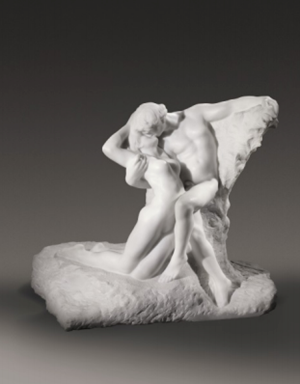
Rodin’s celebrated marble of embracing lovers L’ÉTERNEL PRINTEMPS appearing at auction for the first time in Sotheby’s May sale of Impressionist & Modern Art
Rodin’s celebrated marble of embracing lovers L’ÉTERNEL PRINTEMPS appearing at auction for the first time in Sotheby’s May sale of Impressionist & Modern Art.
Sotheby’s 9 May Evening Sale of Impressionist & Modern Art will feature a rare and exquisite marble of one of Rodin’s most celebrated forms. Conceived in 1884 and carved in 1901-02 from a single block of marble, Rodin's L’Éternel Printemps ranks among his most skillful renderings of embracing lovers. It comes to auction this May with an estimate of $8/12 million*.
This sculpture is believed to be the fifth of ten known uniquely finished carvings of the subject in marble, and was singled out in Frederick Lawton's 1906 biography on the artist as the most magnificent of the series. A Rodin marble of this subject has not appeared on the market in over two decades, and the present example is appearing at auction for the first time this May.
This marble was commissioned by the German diplomat Hellmuth Baron Lucius von Stoedten (1869-1934). Baron von Stoedten, who lived between Berlin and Paris, was a close friend of the poet Rainer Maria Rilke, who played a seminal role between artist and patron in the commission of this marble. Rilke was famously inspired by Rodin's sculptures and wrote a series of poems in their tribute. The friendship between these three great minds of the late nineteenth century tells an intriguing story behind this carving of L’Éternel Printemps.
Other marbles from this series belong in the collections of the Museum of Fine Arts in Budapest (1901); the State Hermitage Museum in St. Petersburg (1906); The Museum of Decorative Arts, Buenos Aires (1907); the Metropolitan Museum of Art, New York (1906-07) and the Ny Carlsberg Glyptotek in Copenhagen (1907-1910).
L’Éternel Printemps was one of Rodin's most celebrated sculptures of the 1880s. The passionate theme preoccupied Rodin throughout his career, and calls to mind the story of Paolo and Francesca—Dante's mythical paramours who were condemned to spend eternity locked in a maelstrom of passion. Rodin later stated that he was listening to Beethoven’s 2nd Symphony when he first conceived of L’Éternel Printemps, and certainly the passion and romance of the great German composer can be felt in this marble sculpture. While his original works dealt in more allegorical terms, Rodin later began treating his subjects with a modernist expressionism. As we find in L’Éternel Printemps, there is a marked increase in the eroticism of his art and a corresponding growth in the daring movement of the poses; this could be a reflection of the artist's studio practice, in which he would allow the models to move freely and independently.

ArtDependence Magazine is an international magazine covering all spheres of contemporary art, as well as modern and classical art.
ArtDependence features the latest art news, highlighting interviews with today’s most influential artists, galleries, curators, collectors, fair directors and individuals at the axis of the arts.
The magazine also covers series of articles and reviews on critical art events, new publications and other foremost happenings in the art world.
If you would like to submit events or editorial content to ArtDependence Magazine, please feel free to reach the magazine via the contact page.